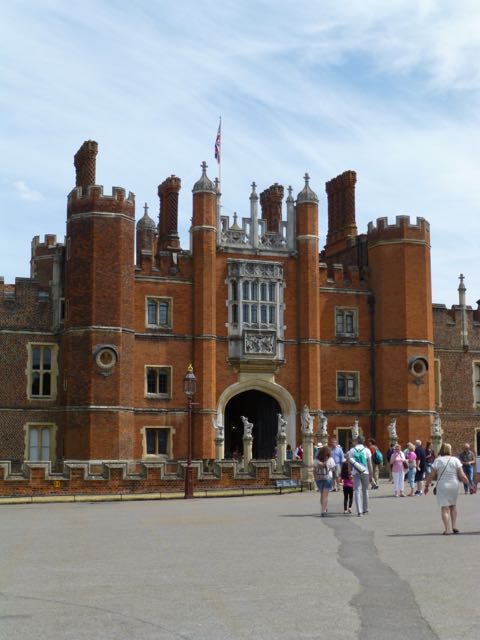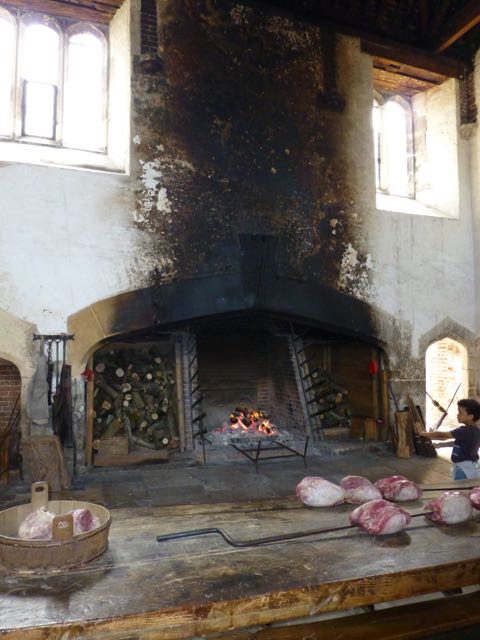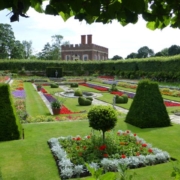Historical Architecture of Grosse Pointe – From Across The Pond – A Visit to Hampton Court Palace.
The two predominant architectural styles in England are Georgian and Tudor. Excellent examples of both can be found all over the country, from castles to cottages, churches, bridges, to chimneys, these structures are visible wherever you go and can be found in the most unlikeliest of places.

An architectural Tudor treasure, and by no means a shrinking violet, Hampton Court Palace was home to Henry VIII, his many wives, and several other Kings and Queens.
History of the Palace
Hampton Court celebrates its 500th birthday this year, and what a life it has had. In 1515 Cardinal Wolsey (a favorite of Henry the VIII) began to transform what had been a private courtier’s house into a glorious bishop’s palace. Over the next seven years, Wolsey spent 200,000 gold crowns to build the finest palace in England. The Tudor style palace, with restrained Renaissance detailing – including a set of eight relief busts of Roman emperors set into the Tudor brickwork – was built to show foreign embassies that Henry VIII’s chief minister knew how to live as graciously as any cardinal in Rome.
It was certainly built to impress however, Wolsey did not get to enjoy his new palace for long. In 1528, knowing Henry VIII was plotting his downfall he gave the palace to the king as a gift. Within six months of taking possession of his new home, the King had begun his own expansion plan to make Hampton Court his principal residence and in doing so transformed it into one of the most modern and magnificent palaces in England.
The Interior
The new palace followed the Tudor style set by Wolsey. One of the first projects was to build vast kitchens, quadrupling them in size to over 36,000 square feet, capable of feeding his court of 1,000 people.

Between 1532 and 1535 Henry added the Royal Tennis Court and the Great Hall. The hall took 5 years to complete. During Tudor times it was the most important room in the palace and it is believed the king had masons work throughout the night by candlelight to complete the room to allow Henry to dine in state, seated at a table upon a raised platform. It also included a stunning carved hammer-beam roof.
In 1540 Henry commission the Hampton Court astronomical clock. The clock was positioned at the gatehouse to the second inner court. It displays the time of day, phases on the moon, the month, the quarter of the year, the date, the sun and star sign, and high water at London Bridge. The Clock still functions today, and takes centre stage in the court. The gatehouse is also known today as Anne Boleyn’s gate, after his second wife.

Henry VIII lived at the palace until his death in 1547. The renovations he made to Hampton Court transformed the residence, but change did not come cheap, the bill in the 16th Century for the rebuilding reportedly came to around $96,000 approximately $28 million today.
Several Kings and Queens including William III and Mary II came to the throne and the palace underwent a second major transformation. William hired the country’s most distinguished architect Sir Christopher Wren to rebuild Hampton Court. The plan was to demolish the Tudor palace a section at a time replacing it with a hugely modern and elegant baroque palace, retaining only Henry VIII’s Great Hall thereby creating the English equivalent of the Palace of Versailles.

The new plan created a central Fountain Court surrounded by two new wings, each overlooking their own stunning garden. Each wing contained the new state apartments and private rooms, one set for the King and one for the Queen, accessed by a state staircase. A gallery running the length of the East Façade, similar to Versailles, also linked the suites. The detailing in the new rooms was impeccable, including frescos, and delicate ironwork.
Many of the rooms of the new palace also contain magnificent decoration on the ceilings. The timber and plaster ceiling of the Chapel is considered the “most important and magnificent in Britain.” While the stained glass window in the Great Watching Chamber is incredible.
The Palace features countless grand fireplaces, taking center stage in many of the rooms. There are superb carvings and motifs on display both inside and out including the ten heraldic animals, known as the King’s Beasts that stand on the bridge over the moat leading to the great gatehouse.
Sadly William and Mary died before they could enjoy their new palace, but the incoming Kings and Queens certainly made the most of the new facilities, enjoying elegant parties.
The Gardens
The formal gardens at Hampton Court Palace are certainly fit for a king. There are no authentic remains of Henry VIII’s gardens, however the grounds as they appear today were created in the late 17th century. The main feature of the grounds is the central avenue that contains the great canal, known as the Long Water, which was excavated during the reign of Charles II, in 1662. It was a vast departure from the usual style’ that was present in many palaces and castles in England (during the era) and was influenced from a similar feature at Versailles.
The gardens are part of the overall design that was created by Wren for the new palace, including the gardens that provided the King and Queen with their own spectacular views when looking out of the windows of their own private suites. A key feature of the garden is the Privy Gardens, which have been restored to their formal glory (from 1702) a stunning symmetrical pattern incorporating many original plants and marble sculptures. The residence also contains several sunken gardens, the image below show’s William III’s Banqueting house in the Background.

A well-known feature of the grounds is the UK’s oldest surviving maze, which was designed in 1700, along with the world’s largest grape vine. Planted in 1769 the vine produces an average crop of 272 kilograms (600lbs) of black dessert grapes.
Hampton Court Palace was last occupied by King George II, he and the Queen regularly used the Palace, particularly during the summer after their accession to the throne in 1727. After King George’s death the palace remained unused until Queen Victoria opened it to the public in 1838.
Written by Katie Doelle
© 2015 Katie Doelle

